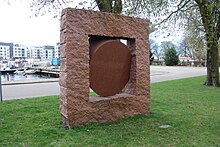Vånga

Vånga is a red gneiss that is quarried near Kristianstad in the Swedish province of Skåne län , near the small towns of Vånga and Oppmanna . It is a natural stone that is widespread worldwide and has been used in Germany since the second third of the 19th century. The rock was formed 420 million years ago in the Silurian .
Surname
Vånga has several names in trade: It is named after the occurrence varieties Vanga and, more rarely, Oppmanna or after the next larger town Arkelstopp or after an occurrence on an island Ivö . Until the First World War he was called neurotic in Germany . Today it is mainly called Rosso Vanga , the name Rosso (German: red ) being of Italian origin. In Sweden it is classified as Vångagranit or earlier Oppmannagranit .
geology
In terms of geology, Vånga is an orthogneiss . Orthogneiss is created by melting igneous rocks . The granitic parent rock was transported into lower layers of the earth's crust by tectonic movements and melted. In this process, the original rock was changed and the mineral structure and texture were completely changed. Gneisses therefore show a clear directional structure. Vånga shows only a weak directional structure, which is attributed to the fact that there was only a “one-sided pressure of the overlying layers”.
Rock description
Vånga consists of red to brownish potash feldspars with a relatively small amount of quartz and streaked biotite , which gives this gneiss a less pronounced directional structure. The red color in the potash feldspars is caused by finely divided biotite. Potash feldspars can be up to 2.5 cm long in this rock.
use
Vånga came to Germany before the 19th century and was used for secular and clerical buildings. It is suitable for exterior and interior construction, floor and facade panels, washbasins and kitchen worktops. Vånga is also used as a pavement in road and path construction .
There is hardly a cemetery in Germany that does not have polished tombs from Vånga. Especially in Sweden it is also worked by sculptors .
Vånga is frost-resistant and easy to polish.
Vånga is only mined in a few quarries, for example in a quarry from Arkelstorp towards Vånga / Näsum on the top of a hill.
literature
- Skåne . In: Theodor Westrin, Ruben Gustafsson Berg, Eugen Fahlstedt (eds.): Nordisk familjebok konversationslexikon och realencyklopedi . 2nd Edition. tape 25 : Sekt – Slöjskifling . Nordisk familjeboks förlag, Stockholm 1917, Sp. 1302 (Swedish, runeberg.org - geological map of the deposit).
Individual evidence
- ^ Friedrich Müller: INSK compact. The international natural stone index for the current market . Sheet 41.1. Vånga . Ebner Verlag, Ulm 1977.
- ↑ skan-kristallin.de : Schweden - Magmatite - Vånga-Granit, accessed on May 8, 2011
- ↑ Karlfried Fuchs: Natural stones from all over the world, discover, determine, use . Callwey, sheet 129. Munich 1997, ISBN 3-7667-1267-5
- ↑ Instructions Vånga quarry travel . emmabodagranit.se (English) accessed on May 15, 2011
